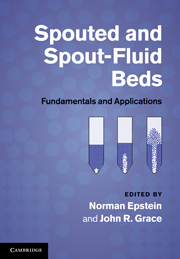Book contents
- Frontmatter
- Contents
- Contributors
- Preface
- Common nomenclature
- 1 Introduction
- 2 Initiation of spouting
- 3 Empirical and analytical hydrodynamics
- 4 Computational fluid dynamic modeling of spouted beds
- 5 Conical spouted beds
- 6 Hydrodynamics of spout-fluid beds
- 7 Spouted and spout-fluid beds with draft tubes
- 8 Particle mixing and segregation
- 9 Heat and mass transfer
- 10 Powder–particle spouted beds
- 11 Drying of particulate solids
- 12 Drying of solutions, slurries, and pastes
- 13 Granulation and particle coating
- 14 The Wurster coater
- 15 Gasification, pyrolysis, and combustion
- 16 Spouted bed electrochemical reactors
- 17 Scaleup, slot-rectangular, and multiple spouting
- 18 Mechanical spouting
- 19 Catalytic reactors and their modeling
- 20 Liquid and liquid–gas spouting of solids
- Index
- References
10 - Powder–particle spouted beds
Published online by Cambridge University Press: 04 February 2011
- Frontmatter
- Contents
- Contributors
- Preface
- Common nomenclature
- 1 Introduction
- 2 Initiation of spouting
- 3 Empirical and analytical hydrodynamics
- 4 Computational fluid dynamic modeling of spouted beds
- 5 Conical spouted beds
- 6 Hydrodynamics of spout-fluid beds
- 7 Spouted and spout-fluid beds with draft tubes
- 8 Particle mixing and segregation
- 9 Heat and mass transfer
- 10 Powder–particle spouted beds
- 11 Drying of particulate solids
- 12 Drying of solutions, slurries, and pastes
- 13 Granulation and particle coating
- 14 The Wurster coater
- 15 Gasification, pyrolysis, and combustion
- 16 Spouted bed electrochemical reactors
- 17 Scaleup, slot-rectangular, and multiple spouting
- 18 Mechanical spouting
- 19 Catalytic reactors and their modeling
- 20 Liquid and liquid–gas spouting of solids
- Index
- References
Summary
This chapter is a systematic summary of the characteristics and applications of spouted beds, called powder–particle spouted beds (PPSBs), consisting of fine powders contacted with coarse particles. The main aspect of conventional spouting that is relevant to PPSBs is the final elutriation of the dried or partially dried fines, often produced by attrition, from a coarse particle bed.
Figure 10.1 shows the operating conditions of several kinds of fluidization for particles of density 2500 kg/m, according to Geldart's classification, indicating also the fine particle size and gas velocity ranges in four reported studies of PPSBs. The two solid lines show the superficial gas velocity at minimum fluidization (Umf) and the terminal velocity of a single particle (Ut). In a PPSB, as one of the operating conditions, the gas velocity is determined by the diameter and density of the coarse particles and is usually greater than Ut of the fine powders, so the fines are elutriated from the coarse particle bed.
Description of powder–particle spouted beds
Conceptual illustrations of a PPSB are shown in Figure 10.2. Group D particles in Geldart's classification usually act as the coarse particles and Group A, B, or C particles as the fine powders. As shown in Figure 10.2a, for a Group C–D particle system, the coarse particles in the bed are first spouted and raw powders (fine particles) in a dry or partially dried state are then continuously fed to the bottom of the spouted bed with spouting gas.
- Type
- Chapter
- Information
- Spouted and Spout-Fluid BedsFundamentals and Applications, pp. 175 - 186Publisher: Cambridge University PressPrint publication year: 2010
References
- 1
- Cited by

